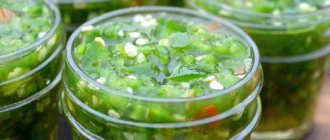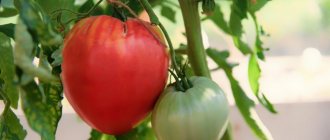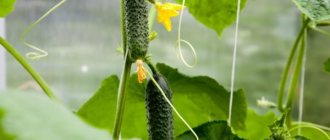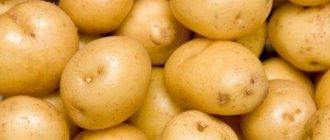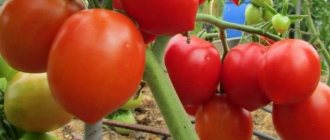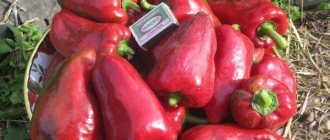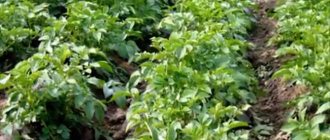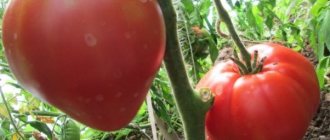- August 24, 2018
- Vegetables
- Olga Simchenko
Shallots, the photo of which helps to recognize this vegetable crop, are very close in their properties and cultivation characteristics to onions. It differs only in its strong branching, smaller heads and much better preservation.
Shallots (another name for them are Ashkelon) are grown primarily for their greens, which are very juicy, tender and contain many vitamins. It is distinguished by its precocity.
Bow feature
Shallot (the photo perfectly illustrates how it looks in cross-section) is a perennial plant of the Allium family, native to Asia Minor. People often call it kushchevka, since during its growth it forms 5-15 heads.
The plant is biennial. In the first year, 5 small onions are formed on it, and in the second year of cultivation they become 2 times larger. The drop-shaped cloves weigh no more than 50 g and are shaped like garlic cloves.
Onion is a plant with delicate, thin and fragrant leaves. They reach 20-45 cm in length, have a waxy sheen and do not become rough for a very long time during the growth process. Knowing what shallots look like, it is impossible to confuse this plant with other varieties when choosing it for planting.
It is very popular due to its low calorie content and is a very good dietary product. This onion is perfect for those who monitor their health and are on a diet. However, despite this, it has a high energy value.
What is a leek: a brief description, photo
Leeks are a biennial herbaceous plant that is widespread in European countries. This product is mainly used in Italian and English cuisine. In our country, this product is used as a seasoning. They mainly use it and greens. The feathers are saturated with ascorbic acid, as well as vitamins B, P, N. The bulbs are small in size, so this onion is practically not grown for heads. It is mainly used in salads and in the preparation of some snacks. At the end, you can add onions to soup and first courses. This will help give the dish a spicy aroma and beautiful color.
leek leek
What varieties are there?
Many gardeners are interested in what shallots look like, what types there are, and how to grow them correctly. He has a lot of varieties. Basically, they are all regional and bred from local cultures under certain climatic conditions. Among the most popular varieties, the following should be highlighted:
- "Kuban yellow";
- "Belozerets";
- "kunak";
- "Berezovsky aristocrat";
- "strong";
- "Sir-7".
The “Kuban yellow” variety belongs to the semi-sharp, mid-early variety. It is drought resistant. The bulb is quite dense, rounded-flat, with 3-4 rudiments. The total weight of slices from one bush is 65-100 g.
The “kunak” variety is mid-season and its growing season is 90-100 days. It has dry, yellow scales with a somewhat brownish tint. Its shelf life is high and its taste is sharp.
The Belozerets-94 variety is an early ripening variety. Its growing season is only 85 days. The total weight of the bulbs from one bush is 100-120 g. Its individual heads are oval in shape and quite dense. They are dark lilac in color. This variety is very productive.
The “Sir-7” variety is early ripening. The bulbs have a pungent taste, a rounded flat shape, and their weight is 20-40 g. The color of the scales is golden yellow, with a slight pinkish tint. There are 4-7 bulbs in one bush. It has very good keeping quality.
The shallot plant of the “Berezovsky aristocrat” variety is classified as mid-season. Its lobules have a wide elliptical shape. They are quite large, approximately 60 g, and there are 5-7 pieces in a bush. The outer scales are dark yellow with a brownish tint, and the inside is white. Its taste is semi-sharp.
The “strong” variety belongs to the mid-late variety. It is recommended to grow it through sets. Its bulbs are small, round, 4-6 pieces per bush. The outer scales are dry, pink, and the inner ones are quite juicy and reddish.
What is lettuce: description of brief characteristics, photo
Nowadays, lettuce has become very popular. But this name was known only among the people, because lettuce is rather a salad. It belongs to the family not of Onions, but of Angiosperms. This plant is closer in origin to cornflower or wormwood than to onion. We have been familiar with this plant almost since childhood; it is often used as food. The additive is especially popular in dietary nutrition. This variety has become very popular due to its low calorie content. It is only 12 calories per 100 g. It is worth noting that the plant is rich in vitamins such as A, E and folic acid. In addition, the composition includes elements such as potassium and calcium, zinc, and magnesium. The plant serves as an excellent additive to fish and meat. Therefore, it is often used in the preparation of main courses and snacks.
Lettuce onion Lettuce onion
Difference from onion
Many people are interested in the difference between shallots and onions and how to recognize them. There are more similarities between them than differences. Similar features include the fact that they have a dense, fleshy bulb, the weight of which is 15-40 g. The green, hollow leaves have a slight bluish coating. They also have similar requirements for agricultural technology, as well as a 2-year growing season.
However, there are certain differences. Shallots are a more winter-hardy crop. It can withstand frosts down to 4-5 degrees and ripens a little earlier than onion. It grows in bushes that can have up to 20 heads. They have a round or oval-cylindrical shape.
The pulp of the bulbs is very juicy, soft and sugary in taste. Shallots are completely unpretentious to storage conditions. It has good shelf life, even at room temperature. In the section, instead of the characteristic concentric rings, several zones with rudiments are clearly visible. You can verify this by looking at the photo of shallots. It is worth noting that the varieties of this culture differ in color and taste. In the southern regions, purple or pink bulbs with sweet flesh predominate. The further north the growing region, the lighter and spicier the shallots.
Plant varieties
Onion varieties differ in taste, level of branching, ripening time and scale color.
Early ripening varieties
“ Belozerets 94 ″ - the plant is formed in seventy-five to eighty-five days, the average bulb weighs twenty to twenty-seven grams and has a pungent taste. The color of the scales is purple, with a lilac tone. The variety is recommended for cultivation in the regions of the North Caucasus.
“ Vitamin basket ” - the bulbs have a pungent taste and weigh thirty grams. A green feather of this variety ripens in eighteen to twenty-two days; leaf lodging occurs seventy days after germination. The keeping quality of the variety is very high. To obtain green feathers in the autumn-winter period, the plant can be grown indoors.
“ Emerald ” is a high-yielding variety with a semi-sharp taste, rounded bulb and snow-white scales. Three or four heads grow in the nest, the mass of each of which is up to twenty-two grams. The variety is grown as a biennial crop. Can be maintained without loss of quality for up to ten months.
“ family ” variety is distinguished by its rounded bulbs, up to four in a nest, semi-sharp flavor and yellow-purple scales. The weight of each head is from eighteen to twenty-five grams. Grows as a biennial crop. Not affected by diseases.
“ Cascade ” is a variety with a pungent flavor and wide-ovate bulbs with pinkish scales. Five to six heads are formed in the nest, each of which can weigh up to thirty-five grams. The variety is grown from sets as a biennial crop. It can be stored for a long time without reducing its beneficial qualities.
Mid-season varieties
“ Albik ” is a variety with a growing season of sixty-two days, high shelf life and productivity. Transverse eleptic bulbs can have a mass of up to thirty grams and yellowish scales. As a rule, from three to eight heads are formed in the nest.
“ Bonnilla F 1 ″ belongs to a variety with a semi-sharp flavor and has a growing season of eighty-two to eighty-seven days. More than four heads are formed in the nest, the weight of each of which can be up to forty grams. The variety produces constant yields of greens and bulbs, can grow and is well stored in one place for up to 5 years.
“ Garant ” is a semi-sharp variety with roundish-flat heads and a growing season of approximately fifty days. The weight of the bulbs, of which there are from three to ten pieces in a nest, can reach thirty-two grams. The variety is recommended for growing indoors and outdoors to produce greens and bulbs.
“ Seryozhka ” is an exceptionally productive hybrid with a growing season of up to fifty-eight days. From four to ten rounded bulbs weighing twenty-five to forty grams appear in the nest. The culture can be cultivated in any habitat. The variety is resistant to bolting and rot, suitable for mechanical harvesting and is perfectly stored.
“ Chapayevsky ” is a multi-purpose shallot with a growing season of sixty-six days. The rounded bulbs have light purple scales and weigh approximately forty grams. Five to eight heads appear in the nest. The variety is very rarely affected by downy mildew, has a long and excellent shelf life, and is suitable for cultivation in the Central Black Earth region.
Mid-late varieties
“ Krepysh ” is a semi-sharp variety with a growing season of eighty to ninety-five days and round-shaped bulbs. The bulbs weighing up to fifty-two grams have pinkish scales and are immune to bolting and rot. The long-keeping variety is suitable for winter planting. Recommended for cultivation in all regions of the country without exception.
“ Siberian Amber ” is a two-year-old crop suitable for cultivation on homestead farms. The growing season of the variety reaches fifty-five to sixty days. The roundish-flat bulbs have yellow-bronze scales and weigh twenty-eight to thirty grams. There are six to eight bulbs in a nest.
“ Ural Violet ” is a semi-sharp variety with reddish-violet scales. Suitable for growing onions. The weight of each head reaches up to fifty-eight grams. The variety reproduces vegetatively and is resistant to bolting and rot. Recommended for breeding in all regions of the country without exception.
Benefits and harms
Experts have long determined what benefits Ashkelon onion brings to the body. Nutritionists say that this product is more dietary than the usual representative. It contains approximately 2 times more vitamins and sugars, but slightly less essential oils. Despite its high calorie content, it is recommended to be consumed even by overweight people.
This onion is not only a food product, but also a very good medicine. In folk medicine, its juice is used to treat colds, diseases of the digestive system and visual organs. In addition, it promotes wound healing and elimination of the inflammatory process.
However, it is worth noting that despite all the beneficial qualities of this product, shallots can still cause some harm. It is not recommended to consume it for people with liver, pancreas and kidney diseases. In addition, constipation and chronic bronchitis are considered contraindications.
What is white onion: brief description, photo
Many people think that white onions are ordinary onions. Actually this is not true. In our country, this onion is not very common, due to the fact that it is quite difficult to store. By the New Year it is almost impossible to find white onions, because the flesh of this vegetable is quite soft and tender. Therefore, the onions are susceptible to rotting. If you are lucky enough to purchase white onions in the summer, we recommend that you use them immediately. It can be stored for very little time, and its taste is significantly different from the taste of onions. It is softer and more gentle. This onion is often called salad onion.
In France, such onions are added to the famous French soup, because they have the ability to completely boil in the broth without leaving any traces. That is, there are no pieces of onion left. It is completely cooked, thanks to this taste it turns out rich. Regarding the content of vitamins and microelements, the composition of such onions is approximately the same as other types. It contains vitamin C, PP, H and B. It also contains trace elements such as potassium, calcium, magnesium, iodine, selenium, sulfur and zinc.
white onion white onion
How to land
Growing shallots is quite simple and can be cultivated in a variety of ways. Often, summer residents on their plots prefer planting this plant in the soil. This can be done in spring or autumn, it all depends on the purposes of cultivating the crop.
You can also sow shallot seeds to produce mature bulbs at the end of the season. In this case, the planting material does not need to be deepened too much. The seeds are slightly covered with fertile soil and then cultivated using standard technology. This is done to update the planting material.
Depending on the region, seeds are sown in autumn or spring. Planting in winter is carried out only in the south. Despite the fact that the crop is characterized by increased frost resistance and tolerates low temperatures well, seed germination is not very high, and harsh winters can reduce it even further.
When planting shallots, you must choose the right location. Like any other vegetable crop, it prefers cultivated soils that contain enough nutrients and moisture. The plant is not too picky about the type of soil, however, its acidity and composition are very important. It is best to grow shallots on light sandy loam soils and loams. They should contain a lot of organic substances and other mineral additives, with neutral acidity levels.
To successfully grow this garden crop, the site should be prepared in the summer. You need to choose a well-lit place. It is not recommended to plant it in the same beds for several years in a row, as this promotes pest damage and the development of diseases, which has a bad effect on the harvest.
Autumn planting begins with the preparation of planting material. Initially, the shallot sets are inspected and calibrated. Then the pest-affected and diseased segments are removed. It is best to select medium-sized ones, as they will give the largest harvest, and those that are smaller can be left for feathering.
Disinfect selected bulbs in a solution of potassium permanganate, fungicides or copper sulfate. Then you need to dry them well. Planting occurs in October, approximately 1-2 weeks before the cold snap sets in. During this time, the segments will have time to grow small roots, but will not send out feathers. This will allow them to survive the winter cold normally.
When planting shallots, you need to leave 20-30 cm between the rows, and 5-15 cm between the bulbs. You need to deepen the planting material by 2-3 cm of soil. After planting, the bulbs need to be covered with peat or covered with fertile soil.
Beginning gardeners would do well to know how to plant shallots in the spring to ensure a good harvest. For this purpose, it is advisable to place it in the soil in March or April, when the top layer of soil warms up to 5-10 degrees. With this method of cultivation, the same planting scheme is used as for the winter.
Description of shallots
Early ripening shallots are a biennial plant, the mention of which dates back to the 3rd century BC. These days it is especially popular in France and is beginning to actively occupy more space on the shelves of different countries around the world. Plant characteristics that all gardeners should know about are presented in the table below:
| Parameter | Description |
| Origin | The origin of this plant has not been precisely established. The first mentions of it were found in the works of Theophrastus (372-287 BC). There is a theory that they first began to eat it about 5 thousand years ago in the southwest of Israel, more precisely in the city of Ashkelon. For this reason, it is also called Ashkelon onion (Allium ascalonicum). According to other sources, shallots come from Asia Minor. Some experts believe that it comes from the Mediterranean region. It is believed that the plant came to Central Europe from Greece in the 13th century thanks to the Crusader knights. Shallots first appeared in the CIS countries in 1958, when they were bred by breeders from the Kuban and Kharkov regions. |
| Cultivation areas | The most favorable areas for cultivating shallots are the southern territories. In practice, it is actively planted not only in Western Europe, but also in Ukraine, Moldova, the North Caucasus and Transcaucasia. Some vegetable varieties are acclimatized and suitable for cultivation in the northern regions. These varieties include Bonilla, Seryozhka and Red Sun Shallot. |
| Growing period | The crop is suitable for cultivation throughout the year. In spring and summer, you can cut off the fleshy feathers with a waxy coating and a pleasant taste, and in the fall and winter, you can collect the bulbs directly. |
| Germination method | The bulbs grow simultaneously, forming a kind of nest of small heads. On one plant there are from several pieces to several dozen heads. Due to this feature, the onion is also called family or nesting. Its other name is magpie. Each head weighs approximately 200-300 g. The height of the shoots on which loose umbrella-shaped inflorescences appear reaches about 100 cm. They also contain flowers that do not have decorative value. |
| Fruit characteristics | The main vegetative organ of the plant is a small bulb, which has the following characteristics:
|
| Planting material | Shallots are often grown by planting heads, so to obtain good planting material there is no need to sow the seeds into sets. So, you only need to leave part of the crop for planting next season. For this feature, onions are also called potato onions. However, during vegetative propagation, it must be taken into account that after some time the bulbs lose their varietal qualities and gradually accumulate diseases, which negatively affects the yield. To correct this, you need to use fresh planting material or grow your own sets from seeds that remain viable for 2-3 years. In the first year they will produce heads that resemble garlic and split into 5 bulbs. When planting them at the beginning of the next season, you can get nests consisting of numerous bulbs. |
| The benefits of onions | Shallots are valued for their medicinal properties - they help with diseases of the gastrointestinal tract and eyes, do not injure the gastric mucosa due to their delicate taste, produce an anti-inflammatory effect and prevent the development of tumors due to the content of flavonoids. Onions are also useful for:
|
| Use in cooking | Both bulbs and feathers are used in cooking. They are used fresh, fried, baked and pickled. In Iran, it is common to serve barbecue with an original sauce - grated shallots with yogurt, and in China popular chips are made from it. Shallots are especially popular in France, where they are used to prepare most sauces, delicacies and dishes containing poultry and wild animals. |
| Contraindications | If you have problems with the gastrointestinal tract or urinary system, shallots should not be eaten in large quantities, as they can make urination difficult. It is recommended to exclude it completely from the diet in case of bronchial spasms, kidney and liver diseases. In addition, onions are contraindicated for people with high stomach acidity - they increase the acid level and thereby cause irritation of the mucous membrane. |
The secrets of shallots are described in the following video:
Growing and care
After planting onions, you need to follow certain rules for growing and caring for them. Before the first shoots appear, you don’t need to do anything, not even water. After the first moistening, the soil is mulched with mowed grass. The watering schedule is once a week. You will need 20 liters of water per 1 m2. Watering is carried out at least 3 times per season. It is better to water rarely, but quite abundantly. It is undesirable to allow water to stagnate.
The soil needs to be loosened 1-2 times a week and weeds removed in a timely manner. To grow larger onions, you need to thin out the seedlings a little at the beginning of July. This will give neighboring plants more nutrients and more space to grow. There is no need to water or fertilize, since instead of growing the bulb, the shallots will continue to strengthen the leaves. The arrows must be removed upon reaching a height of 10 cm.
The first feeding is carried out approximately 2 weeks after germination of most of the bulbs. To do this, you need to use mullein and bird droppings, which must be diluted with water 1:10. Fertilizer must be applied 1 bucket per 1 m2. If it is not possible to fertilize with organic means, then you can use superphosphate and saltpeter. The second enrichment procedure is carried out during the formation of the bulbs and potassium chloride or superphosphate is used for this. From the beginning of July you need to stop fertilizing and watering.
Specifics of cultivation
Family onions are planted on both feathers and turnips. It differs from traditional onions in its very high frost resistance and short growing season. Fresh greens are ready to eat approximately 3 weeks after planting, and the bulbs take about 2 months to ripen.
Benefits also include:
- friendly lodging of leaves, which occurs before the onset of seasonal outbreaks of peronosporosis and other diseases;
- exceptional keeping quality of the bulbs, which can be stored for up to 2-3 years without loss of commercial and consumer qualities. Unlike onions, shallots do not dry out, do not sprout, do not rot, they remain tasty and capable of further growing season even after complete freezing (one time);
- high yield when forcing greens and obtaining turnips due to the formation of “nests”. The mass of the bulbs in each of them averages 200-300 g.
The productivity of shallots depends on the varietal characteristics, soil and climatic conditions and the agricultural technology used
Like other onions, shallots are light- and moisture-loving, and demanding of soil fertility. He needs to allocate a flat, well-lit place on the site, freed up after harvesting potatoes, tomatoes, cucumbers, cabbage, legumes, pumpkin or cereal crops. It is recommended to dig up and enrich the soil by adding mature organic matter (humus or compost at the rate of 3-5 kg per 1 m2) and mineral phosphorus-potassium fertilizers (superphosphate 1 tsp, wood ash 1 cup per 1 m2). If the soil is highly acidic, alkalization should be carried out using dolomite flour, slaked lime or chalk - in acidic soil, shallot leaves will turn yellow early and the bulbs will turn out small. In areas with high groundwater levels, it is advisable to prepare raised beds for onions. An experienced gardener tells how to do this in the following video:
Before planting, the bulbs must be carefully examined, removing all suspicious ones, and sorted by size. They are planted in a row, small ones with an interval of 8-10 cm, medium ones - 15-20 cm and large ones - 20-30 cm from each other. Make a distance of 30-40 cm between the rows to prevent thickening, which leads to smaller turnips and contributes to the development of fungal diseases.
Prepared furrows 5-6 cm deep are shed generously with water and the heads are placed so that the layer of soil above them is 2-3 cm thick. To speed up the regrowth of greenery, some vegetable growers cut off the tops of the bulbs and peel them, but this leads to a decrease in yield.
Landing dates
Early spring planting is considered optimal for shallots . In some regions it is planted even during the February thaw “windows”, but basically this work is carried out at the end of March - April. To form bulbs, the plant requires long daylight hours (14-16 hours). With a sufficient amount of moisture in the soil, warmed up to 8...15 ℃, shallots quickly take root and sprout in 12-14 days. Warmer temperatures stimulate leaf growth, but roots grow poorly and do not provide the necessary amount of water and nutrients. This leads to poor ripening of the bulbs and the formation of unmarketable “thick necks”.
Planting material is sorted by size and, for disinfection, soaked in a weak solution of potassium permanganate or some fungicidal preparation for 10-30 minutes
Autumn planting is advisable in the southern regions and where large amounts of snow fall in winter. It is usually carried out from the third ten days of September to mid-October. At the same time, the issues of storing planting material disappear, and plants that have taken root in the fall receive a large supply of moisture in the spring and produce an earlier harvest of greenery (at the beginning of summer) and bulbs, which are 8-12 days ahead of spring ones in ripening.
For pre-winter planting, varieties with a high (at least 20%) dry matter content that are resistant to bolting are recommended, for example, “Albik”, “Andreika”, “Garant”, “Debut”, “Nafanya”, “Siberian Yellow”, “Syr” 7”, “Sophocles”, “Spartak”, “Ural 40”, “Ural red” and purple, “Chelyabinsk pink” and some others.
Plant care
Shallot responds well to standard agricultural practices. Watering is required mainly at the initial stage of active growth and during dry periods.
Timely watering is especially important at the time of mass emergence of seedlings in dry and hot weather
fertilizing with slurry (1:10) or infusion of chicken manure (1:15 or 1:20) in early to mid-June You can also use ready-made mineral complexes (30-40 g per 10 liters of water). After fertilizing, the plants need to be watered abundantly.
The soil between the rows is mulched or loosened throughout the entire growing season to ensure access of oxygen to the roots and prevent the development of onion fly larvae. To prevent common diseases and control pests, onion beds need to be weeded, clearing them of weeds, and, if necessary, treated with fungicidal preparations, for example, Mikosan-V, Pentafag-S, Quadris.
Flower shoots that are not intended to produce seeds must be broken off immediately after appearance (while they are less than 10 cm) at the level of exit from the leaf axil.
At the stage of isolating the bulbs in the “nest”, around the beginning of July, it is recommended to carry out rationing , keeping 3-4 shoots and completely removing the rest. This way, ripening turnips will receive additional feeding area, more intense lighting and, naturally, will grow larger. Greens, torn out along with the bulbs, are used for current consumption or processing (drying, freezing). After thinning, the plants are no longer watered or fed - excess moisture and excess nitrogen lead to worse ripening of the heads and a decrease in their keeping quality.
Harvesting and storage
Harvesting of shallots begins 3-7 days after the leaves have fallen together. For early varieties this occurs around the beginning of July, and for medium varieties - in the third decade. It is better not to delay the harvesting time, as the onions may begin to sprout again. The bulbs removed from the ground are left for several days to ripen in the beds (in dry weather) or in a well-ventilated area. Then the dried leaves are torn off or braided into braids, which are conveniently stored hanging.
Well-dried shallots (pictured) can be stored for over a year at home.
It is better to keep the harvest intended for consumption in the cold (at temperatures from 0 to +5 ... 10 ℃) and low humidity (60-70%). Bulbs selected for spring planting are recommended to be stored in a dark and warm (+18…25 ℃) place.
Practice shows that when cultivating shallots in summer cottages, you can regularly obtain yields that are twice the consumption of planting material.
Diseases and pests
Onions can be affected by various diseases and pests. Fungal infections include powdery mildew, neck rot, and fusarium wilt. In addition, the beds may suffer from flies and onion nematodes. In particularly hot weather, feathers are often parasitized by aphids.
The best way to combat them is to use pesticides. It is important to remember here that there are certain restrictions on the consumption of bulbs and greens in food. If the situation is not too advanced, then you can use folk remedies.
To prevent the appearance of pests and diseases, it is necessary to strictly observe crop rotation and replace old planting material in a timely manner. In addition, you need to refuse to plant suspicious and diseased bulbs in the beds.
Shallots should not be placed next to other types of this crop, since they have the same diseases and pests, which gradually accumulate and overwinter in the soil.
Plant care
In order for a culture to grow and develop normally, it needs to be provided with complete and high-quality care.
Top dressing
During one growing season, onions must be fed twice. Fertilizers should be applied for the first time in the spring - at the stage of the appearance of the first three feathers. In this case, urea or urea is used. For 1 bucket of water it is recommended to take 1 tbsp. l. substances. To the resulting mass you need to add 0.5 tbsp. potassium
The onion is fed the second time when the fifth feather appears, when the crop needs potassium monophosphate. For 1 bucket of water you should take 1 small spoon of this product.
Watering, loosening
During the first time after planting, the plant needs to be watered quite often, using a large amount of water. 21-28 days before harvest, the amount of liquid is gradually reduced. This helps dry out the feathers and bulbs.
Periodically, the beds need to be loosened and weeded so that the crop can receive the required amount of oxygen for development. Loosening helps to avoid the appearance of a dense crust on the surface of the earth. Otherwise, sufficient moisture will not reach the roots. Also, regular weeding of the soil gets rid of weeds that suppress the growth of the vegetable.
Onions need to be watered promptly
Pest protection
The plant may suffer from fungal growth. Most often it is attacked by downy and ordinary powdery mildew. Also, onions often suffer from neck rot or downy mildew.
Affected crops begin to wither and saving them is almost impossible. To avoid contamination of healthy vegetables, diseased specimens are completely destroyed. In this case, the remaining plantings are treated with Quadris and Pentophage.
To avoid fungal infections, before planting, you need to soak the seedlings in Maxim’s solution for half an hour.
Often crops suffer from pest attacks. Most often, plantings are attacked by the following insects:
- Onion fly. In this case, the vegetable and the soil around it should be treated with wood ash.
- Worms. Ground fragments of the plant should be watered with saline solution. To make it, 1 tbsp. salts should be mixed with 10 liters of water.
- Onion nematode. May lead to distortion of the bottom of the mother vegetable. Damaged crops must be removed immediately.
- Aphid. Insects attack onion feathers. To cope with them, you need to use a decoction of pepper, chamomile or potato peel. Among the chemicals you should choose Verticillin.
The plant may suffer from dangerous pests
Harvesting, fruit storage
Harvesting shallots begins when the leaves of the plant dry. Ripe fruits are dug up in August, trying to avoid damaging their integrity. Before harvesting, you need to dry it and cut off the dry tops.
Important! The bulbs must be sorted and placed in boxes or wooden crates. Vegetables are stored in a dark and cool place.
Onions must be thoroughly dried before storing.
Shallots are a sweeter and more delicate counterpart to onion varieties. Even a novice gardener can grow the crop. The plant adapts even to unfavorable climates and does not require special care.
Harvesting and storage
You definitely need to know when to remove shallots from the garden and how to do it correctly. Harvest usually begins in July. You can dig up a plant from the garden when most of the greenery on the bushes has dried out. There is no point in keeping shallot bulbs in the ground, as they can easily germinate again. You need to dig up the heads sown with seeds in the winter a little later and this is done around August or September.
Harvesting onions is not particularly difficult. The bushes are carefully dug up with a pitchfork or shovel, then taken out of the ground and disassembled into individual fruits. The harvested crop is well dried in the sun or under a canopy. Then the tops are cut so that a small neck remains, about 2-3 cm. Large bulbs can be braided.
Shallots should be stored at home like regular onions. It is placed in small boxes made of plastic or wood. You need to keep the harvest in the basement, cellar, or on the balcony. Shallots braided in braids last especially long.
Planting shallots
The prepared planting material must be planted in moist soil, adhering to the following scheme:
- distance between rows – 30-40 cm;
- the distance between the bulbs in a row is 20-30 cm;
- the distance between seeds in a row is 8-10 cm;
- the depth of planting the bulbs is 2-3 cm (if planted deeper, the growth of greenery will be delayed and the yield of the variety will decrease, and if they are planted at a shallower depth, the bulbs will stick out from under the ground);
- the depth of seed placement is 11-13 cm with the bottom down (however, in the southern regions you should not deepen the shallots deeper than 10 m, since planting too deeply will increase the harvest time).
After planting, the bulbs need to be sprinkled with soil mixed with wood ash (3:1) and watered. The planting should also be mulched - covered with a layer of peat or humus 3.5 to 4 cm thick. If onions are planted in the fall, then the beds can be covered with spruce branches, which will need to be removed in early spring.
If the seedlings are not additionally protected from the cold, they can withstand temperatures as low as -25°C. At lower rates, crop yields can be reduced by 3 times.
How to plant and grow shallots is clearly shown and explained in the video below:
Breeding rules
When growing and propagating shallots, certain features must be taken into account. If you plant it for several years in a row in the same place, the quantity and quality of the harvest begins to decrease. When growing shallots in irrigated areas, they begin to degenerate after 20-25 years.
It is very important to periodically update planting material. To do this, it is recommended to resort to propagation by seeds. When planting shallots in the spring, 7-12% of the plants shoot, and when planting in the fall - about half or even more. Seeds are formed on a crop whose bulb mass reaches at least 60 g. Such plants can already form more than 4 arrows. It is worth noting that the seeds of shallots are somewhat smaller than those of regular onions.
When planting shallots, you need to take into account the fact that they can quite easily interbreed with regular onions, which is why it is recommended to place them separately. Legumes are considered the best predecessors. Shallots can be planted in the same area no earlier than after 3-4 years.
To obtain seeds, the bulbs need to be immersed in the soil in the second half of November. This area must be kept away from the seeds of other onion varieties.
If you pay attention to the photo of shallots below, you can see how interesting the culture is being formed. Thanks to this structure of the bush, a fairly decent harvest grows from a small handful of seeds.
What is an ordinary onion: description of brief characteristics, photo
Onions are a perennial herbaceous plant that grows here for two or three years. It is distinguished by a brownish or yellowish dense husk. Inside, after cutting, you can see white-green flesh. It is characterized by a sharp aroma and sweetish-bitter taste. Most often, this onion is used in cooking. Since it grows well in our latitudes, many housewives add it when preparing soups and main courses, as well as salads. To prepare salads, onions are usually pre-pickled or poured with boiling water. This is done in order to eliminate the bitter taste.
Regarding useful elements, onions contain ascorbic acid, phytoncides, B vitamins, PP. In addition, it is high in sulfur, calcium, potassium, and zinc. This set of vitamins and microelements allows this vegetable to be used in the treatment of many diseases. High anthelmintic activity is noted. Onions can be used to treat worms and helminthic infestations. It is stored for quite a long time, after harvest and until next year. That is, you can easily save onions until the next harvest. It is thanks to this property that this vegetable is grown.
onions onions
Use in cooking
Shallots are widely used in cooking. It is simply consumed as food and used as a seasoning for various dishes. It has its own unique aroma and taste, so it gives dishes its own unique flavor. In addition, this type improves the digestion process and stimulates appetite.
The leaves and bulbs of shallots serve as a good seasoning in cooking. They are prepared in salads, added to meat dishes, soups, omelettes, marinades, and sandwiches. In addition, they are included in various canned foods. Recently, shallots have found wide use in English and French dishes, where they are used instead of onions.
Young leaves of shallots are consumed as food, cutting them off several times during the season. In addition, you can eat the onions. They have a very pleasant aroma and semi-sweet taste, without a sharp bite. After eating shallots, there is no unpleasant aftertaste; it does not overwhelm the notes of other ingredients in the dish.
For culinary purposes, you can use not only fresh, but also pickled and frozen onions. This peeled vegetable baked in the oven is used to prepare sauces and seasonings. After cooking, it is very easy to peel and grind to a puree.
Due to their high dry matter content, shallots caramelize very well. It can be fried until brown, but this must be done gradually over low heat.
Product and consumer qualities
Shallots are especially respected by housewives who love to prepare delicious gourmet dishes. It is considered an essential ingredient in most classic French recipes. Small bulbs with thin scales have a pleasant sweetish-sharp taste that does not overwhelm other products. They are easy to cut and practically do not cause tears. Shallots have a universal culinary purpose and are perfect for dietary nutrition. It can be used as a constant source of fresh aromatic herbs by growing it at home on a windowsill in winter. Thin feathers grow in a compact, lush bunch and remain delicate for a long time.
Pickled onion pickles are served as a savory appetizer or as a side dish for meat and fish dishes.
Shallot bulbs are superior to regular onions in terms of dry matter and sugar content, so they caramelize perfectly and become even tastier after heat treatment. The chemical composition of greens and onions also contains vitamins C and group B, phytoncides, carotenoids, essential oils, macro- and microelements (iron, phosphorus, potassium, calcium, cobalt, chromium, nickel, molybdenum, silicon, etc.).
Reviews from summer residents
Shallots have earned very good reviews from summer residents, even though their yield is somewhat lower than that of onions. Many say that it has excellent taste and has a long shelf life. Gardeners value this vegetable for its excellent taste. You can cook absolutely any dishes from it, even desserts. Moreover, it can be consumed fresh as it is not spicy at all.
Farmers write that shallots ripen much earlier than onions, and also have a more pleasant taste, despite the fact that they have small heads. They are not at all caustic. Excellent for preparing first and second courses, as well as salads.
According to reviews, shallots are very popular among summer residents, as they are easy to grow, early ripening, good keeping quality, and excellent taste.
You can get an early harvest in open soil. The best growing method is to plant bulbs. The seeds are best used for growing seedlings. In garden plots, several different varieties can easily be cultivated at once, but they need to be planted at a distance from each other to avoid cross-pollination.
Beneficial features
Regular consumption of shallots in food helps to improve and restore many systems of the human body, but its beneficial effects are not limited to any specific area:
First of all, this vegetable cleanses the body of parasites, viruses and bacteria. The main share of disinfectants are phytoncides, and the main cleaning occurs in the digestive tract. With a decrease in permeability and absorption, undigested food remains remain here, which begin to rot and create pathogenic microflora. Onion pulp and juice, entering the stomach and intestines, destroy the bacterial environment and, stimulating motor functions, promote the removal of toxins. True, sometimes the high activity of phytoncides can cause harm; such situations will be discussed below in the corresponding section. Thanks to the presence of potassium, sodium, magnesium and some vitamins, the circulatory system is put in order. The walls of blood vessels become elastic and strong, blood pressure is normalized, and the tone of the heart muscle increases. And iron stabilizes the blood composition and maintains hemoglobin levels within normal limits. A large amount of antioxidants and vitamins of the group helps rejuvenate the body. These substances improve metabolic processes in tissues, neutralize the effects of free radicals, and promote the elimination of toxins and cholesterol. With sufficient content, the skin remains elastic and healthy, hair, teeth and nails are strengthened. Shallots have a decent supply of vitamin A - 100 grams contain 8.7% of its daily value
Of course, these are not record figures, but regular consumption of onions helps maintain visual health. Scientists pay special attention to the presence of quercetin and allicin in shallots. These antioxidants have a good hypertensive effect, that is, they lower blood pressure
Research from the Hong Kong Polytechnic University has shown that allicin is one of the protectors of the cardiovascular system. It neutralizes reactive oxygen species, due to which it produces another antioxidant - glutathione, which is necessary to protect immune cells. Their main weapon in the fight against enemies of the body are free radicals, but with a lack of glutathione, the immune system itself comes under fire, causing serious disorders. In addition, glutathione protects cells from oxidizing vitamins C, E, A, also involved in the fight for health. Allicin also regulates the process of natural reductase production. This enzyme is produced by the liver and has its own function (vasodilation, blood pressure control), but in excess it leads to the formation of excess cholesterol. Shallots contain a lot of potassium, which is necessary to maintain a healthy water-salt balance and muscle tone. This macroelement is also involved in carbohydrate metabolism and improves metabolism. Complex compounds entering the body along with onions help fight obesity. They prevent lipid oxidation, which causes fat storage in the body. Onions are also good for obesity because they affect the problems that often accompany this disease: diabetes, the threat of cancer, disorders of the cardiovascular system. Thus, shallots work not only with excess weight, but also with its causes and consequences.
Shallots are an excellent alternative to onions because they have a milder taste, but are not inferior in health benefits. Doctors recommend using it for a general strengthening effect on the body, improving the functioning of the gastrointestinal tract and eye health. Fresh shallot bulbs and leaves are added to dishes, salads, and, if desired, can be eaten separately as an appetizer for main courses. Less commonly, it is pickled in combination with vegetables or separately.


